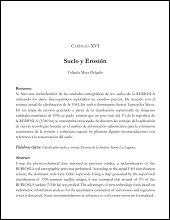LA INVESTIGACIÓN CIENTÍFICA Y LAS ÁREAS NATURALES PROTEGIDAS EN MÉXICO: UNA RELACIÓN EXITOSA
Autor
GONZALO HALFFTER SALAS
CLARA LEONOR TINOCO OJANGUREN
LUIS IGNACIO IÑIGUEZ DAVALOS
ALFREDO ORTEGA RUBIO
Metadatos
Mostrar el registro completo del ítemResumen
"Uno de los objetivos declarados de las Áreas Naturales Protegidas (ANPs), en especial de las reservas de la biosfera, es prestar apoyo logístico para el desarrollo de programas de investigación, de educación y capacitación. En los países desarrollados el principal vinculo que se da entre la investigación científica y las ANPs, es el de un florecimiento de artículos y publicaciones científicas una vez que una ANP ha sido creada. En México la relación entre la investigación científica y las Áreas Naturales Protegidas (ANPs) se establece en fases mucho más primordiales de las ANPs; de hecho las primeras reservas de la biosfera de México han surgido del trabajo y tesón de investigadores científicos mexicanos laborando en instituciones de educación superior o en centros de investigación. En este trabajo se analiza, como estudios de caso, la génesis y gestión de las siguientes ANPs (todas ellas reservas de la biosfera): La Michilía, Mapimí, Sierra de Manantlán, Los Tuxtlas, Chamela- Cuixmala, el Desierto del Vizcaíno, el Archipiélago Revillagigedo y la Sierra La Laguna. Los resultados de este análisis establecen que en nuestro país la primera y la segunda generación de las ANPs contemporáneas han estado indisolublemente ligadas a los esfuerzos de grupos de investigadores que laboran en instituciones de educación superior o en centros de investigación. Pero la relación simbiótica no concluye allí; una vez promulgadas, con esfuerzos tesoneros de los propios investigadores que pueden llevar muchos años, los proyectos de investigación que se desarrollan incluyen tanto estudios que contribuyen al conocimiento profundo de la biota, desde los taxonómicos hasta los etológicos y ecológicos, como aquellos enfocados a generar alternativas de uso y manejo sustentable de los recursos bióticos y abióticos de la ANP en cuestión. Indudablemente, la intensificación de la simbiosis entre la investigación científica y el manejo y gestión de las ANPs es uno de los ejes principales con los que podemos alcanzar el anhelado objetivo de nuestro desarrollo sostenible." "One of the stated objectives of the Protected Natural Areas (PNAs) is to provide logistical support for the development of programs on research, education and training, so in developed countries the main link that exists between scientific research and PNAs, is a blooming of scientific articles and publications once a PNA has been decreed. However, in Mexico the relationship between scientific research and the Protected Natural Areas (PNAs) is set in more primordial stages of PNAs. In fact, some of the first contemporary PNAs in Mexico that have sought as main objective the protection of biodiversity, have emerged from the work and tenacity of Mexican scientific researchers working in higher education institutions or research centers. In this paper are analyzed, as case studies, the genesis and management of the following PNAs: Michilía, Mapimí, Sierra de Manantlán, Los Tuxtlas, Chamela-Cuixmala, the Vizcaino Desert, Revillagigedo Archipelago and Sierra La Laguna. The results of this analysis establishes that, in our country, the first and second contemporary generation of NPAs have been inextricably linked to the efforts of research groups working in higher education institutions or research centers. But the symbiotic relationship does not end there; once promulgated, with lobbying efforts by the researches that can take many years, research efforts following the promulgation included studies contributing to the deep knowledge of the biota, including from the taxonomic to ethological and ecological perspective, as well as those generating alternatives for the sustainable use and management of biotic and abiotic resources of the PNAs. Undoubtedly, to intensify the symbiotyc relationship between scientific research and the management of PNAs in Mexico will be one of the cornerstones to achieve the desired goal of our sustainable development."
Colecciones
Ítems relacionados
Mostrando ítems relacionados por Título, autor o materia.
-
PROMOCIÓN DEL PERIFITON PARA EL CULTIVO DE CAMARÓN BLANCO: HACIA UNA ACUICULTURA ECOLÓGICA
DOMENICO VOLTOLINA LOBINA; JUAN MANUEL AUDELO NARANJO; MARIA DEL ROSARIO PACHECO MARGES -
Suelo y Erosión
YOLANDA LOURDES MAYA DELGADO


